
For an explanation of the State-By-State series, click here.
To view previous State-By-State articles, click on the “State
By State” link under the "Labels" listed to the left.
Situated in the 4th Corps Area, Louisiana was
home to a wide range of CCC camps. Perry
Merrill notes that an average of 30 CCC camps operated in Louisiana between
1933 and 1942, with some 51,225 individuals working in the state, regardless of
their state of origin.
The Annual Report of
the Director of Emergency Conservation Work for fiscal year 1937 reported
that the total enrolled strength in Louisiana by month was as follows:
July 1936: 6,989
August 1936:
6,662
September 1936:
5,483
November 1936:
6,437
December 1936:
6,242
January 1937:
6,795
February 1937:
6,573
March 1937:
5,547
April 1937:
6,572
May 1937:
6,271
June 1937:
5,798
During that same fiscal year, a total of 6,869
enrollees were enrolled in Louisiana, though as we know, not all of them
remained in Louisiana; odds are some were shipped out to work in other states. Some specific work undertaken by CCC
enrollees in Louisiana in fiscal year 1937 included:
New Buildings: 262
Earthen Dams:
44,490 cubic yards
Fighting Forest Fires: 12,495 man days
Mosquito Control:
210 acres
Insect Pest Control: 775 acres
 |
| Col. Thomas D. Osborne and Headquarters Staff, Fourth Corps Area, District "E", 1935 |
It would seem that, in accordance with racial segregation prevalent at the time, the 1935 District “E” Annual is divided by race, with the all black, African-American CCC companies relegated to the rear of the book. Among the companies listed there, is Company 3498, assigned to camp Army-1-L at Barksdale Field, Louisiana under Lieutenant James C. Barlow. Often, if a local community expressed opposition to having an all-African-American (“Colored”) CCC company stationed nearby, the federal government would respond by finding work for the Colored company on a nearby military base and it is possible that Barksdale Field was the beneficiary of just such an arrangement. The work of Company 3498 is described in the 1935 District Annual:
“Road building to the airport proper and over the
reservation has been a major work of the Using Service. Emergency landing fields are also being
built. A saw mill is operated to utilize
the timber being cleared from the roads, and landing fields. Some of this lumber is used in making
bridges. A great portion of it is used
each week to construct targets for the planes on the ranges. Targets do not last long when bombed by a
group of planes in practice.”
 |
| Company 3498, Camp Army-1, Barksdale Field, Louisiana |
Another all-African-American CCC company was assigned to
work on Barksdale Field during this period.
Company 3499 was assigned to camp Army-2-L at Barksdale Field. According to the 1935 Annual, the camp was located a quarter mile from Bodcau Station
near the I.C Railroad. The camp was
established by an initial cadre of 15 white enrollees from Company 1440,
Marion, Louisiana, 125 colored enrollees from Baton Rouge and nearby
communities and an additional 50 colored enrollees from Lafayette and adjoining
parishes. The objectives for Company
3499, according to the Annual, included
the improvement of Barksdale Reservation by 1) building 25 miles of gravel
roads, 2) building of 25 miles of dirt road with bridges, 3) building of two
emergency landing fields and gun ranges, 4) planting of 1000 pecan trees on
highways in the reservation, 5) building fire prevention roads and fire breaks,
6) giving proper drainage to the entire 22,000 acres.

Camp L-73-L at Marksville, Louisiana in Avoyelles Parish was home to Company 1481 according to the 1935 District Annual. The camp was actually situated 6 miles north of Marksville “in the little village of Moncla, on the banks of the Red River.” Company 1481 was a “Colored” company as well, with white officers and foremen. The educational advisor for the company was African American.
In Morehouse Parish, Bastrop, Louisiana was home to camp
SP-4-L, where Company 478 was stationed in 1935. Here, so the narrative goes, a group of CCC
boys from Georgia became a bit homesick because of a stretch of dismal weather
at Bastrop which was not like the bright sunshine they’d left behind in
Georgia. The narrative goes on to say
that the boys were cheered up immensely by “a big Thanksgiving dinner prepared
under the careful direction of the Assistant Mess Inspector, Second Lt. Bryce Alexander,
348th Infantry. The members
were ‘just kids’ again as they sat down to the appetizing meal that made their
away from home Thanksgiving complete.”
Jonesboro, Louisiana in Jackson Parish was home to Company
4413 at camp SCS-8-L during 1935. The
camp was under the command of Captain Stanton A. Hall with Ensign F.E.
Johnstone serving as Executive Officer.
The District Annual refers to this camp as “Camp Colvin” and records
that it was established on August 2, 1935 with an initial detail of 139 men
from New Orleans and its suburbs. After
being confined to camp for two weeks, the enrollees were put into the field “to
conserve the soil of the District..” and “For many of these boys, it was their
first experience with pick and shovel and you should have seen how they handled
them for a few days.” A highlight of the
period was the Jackson Parish Fair, held at the camp from October 16th
to the 19th, during which time more than 8,000 people visited the
camp. “Everyone seemed to like the Camp
and it gained some mighty good publicity and made friends of people from whom
co-operation is needed to make the Soil Conservation project a success. All the credit for the success of the Fair
belongs to the excellent company commander, Capt. Stanton A. Hall. He was the ‘daddy’ of the Fair.”
In 1935, Company 5408 was assigned to the CCC SCS-1-L at
Minden, Louisiana in Webster Parish, under Lieutenant H.A. Strickland,
commanding officer and Lieutenant C.A. Harris, executive officer. The narrative camp history reports that the
enrollees in Company 5408 had an array of diversions to keep them busy,
including an educational program that offered course work in typing and wood
working as well as recreational activities such as baseball, boxing, ping pong,
horseshoes, billiards, shuffleboard, volleyball, checkers, basketball and
bowling as well as books, newspapers and magazines. Nevertheless, the company history reports
that “many of the boys have fallen victims of the dreaded ‘acute homesickness,
and the song ‘Two Tickets to Georgia’ has been so popular that the original 198
dwindled to 128 men.”
Other notable events and accomplishments reported in the
1935 District “E” Annual include:
The company history for Company 1476 at camp F-1-L, Pollock,
Louisiana, reported that camp exchange officer Lieutenant Eugene Paletz directed the construction of a
“Woodrow Wilson Heart” in the center of camp as “ a reminder of the love and
esteem for the late president after whom the camp is named, Woodrow Wilson.”
On Labor Day, 1935, Company 4421 at camp L-SCS-18, Mount
Hermon, Louisiana, hosted a chicken dinner to which were invited the citizens
of the surrounding communities. A U. S.
congressman attended the event during which the camp was renamed “Camp
Sanders,” and the mess hall and recreation building dedicated as “Melvin Smith
Hall and Oscar James Hall” respectively.
Enrollees Smith and James were killed I a bus accident while traveling
home on a weekend pass.
Author’s Ren and Helen Davis provide a glimpse of long-term
state park impact of the work of the CCC in Louisiana in their book Our Mark on
This Land (2011). At Chemin-A-Haut State
Park near Bastrop, enrollees created a wooded park that overlooks Bayou
Bartholomew and the lodge there is host to a CCC exhibit. At Chicot State Park near Ville Platte, the
CCC constructed a dam and spillway structure as well as picnic shelters and a
group camp dining hall. Fountainebleau
State Park, on Lake Ponchartrain was established in 1936 and developed by CCC
enrollees. Here visitors will still see
the park entry structures and roads built by the enrollees, as well as trails and
historic structures.
Here are additional images taken from the 1935 Official
Annual of District “E,” Fourth Corps Area Civilian Conservation Corps:
 |
| Survey crew, Company 4411, Camp SCS-6 Calhoun, Louisiana |
 |
| Camp F-5, Dry Prong, Louisiana |
 |
| A friendly boxing match at Camp F-5, Dry Prong, Louisiana |
 |
| Enrollees from Company 4491, Camp SCS-21, Keithville, Louisiana |
SOURCES
Davis, Ren & Helen, (2011), Our Mark on This Land: A Guide to the Legacy of the Civilian
Conservation Corps in America’s Parks, The McDonald & Woodward
Publishing Company.
Official Annual for
District E for 1935, Direct Advertising Company, Baton Rouge, LA.
Merrill, Perry H, Roosevelt’s
Forest Army, 1981, Perry H. Merrill, Publisher.
U.S. Government Printing Office, Annual Report of the Director of Emergency Conservation Work, Fiscal
Year Ended June 30, 1937.
Copyright, 2014, Michael I. Smith





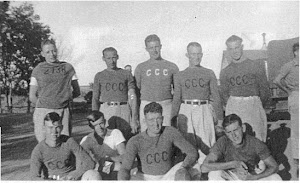

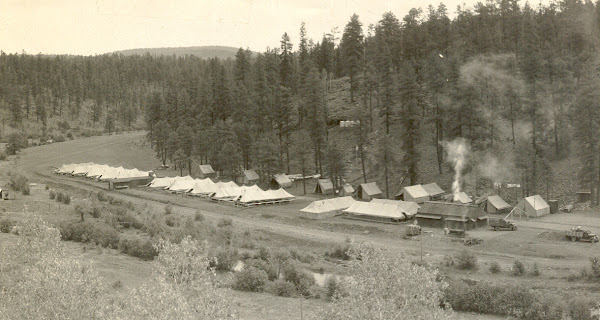

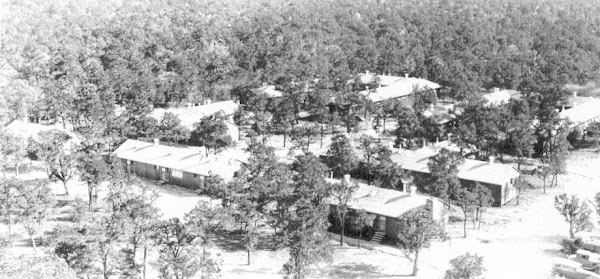



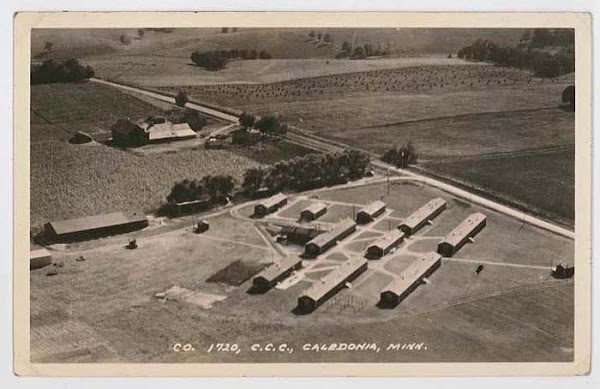
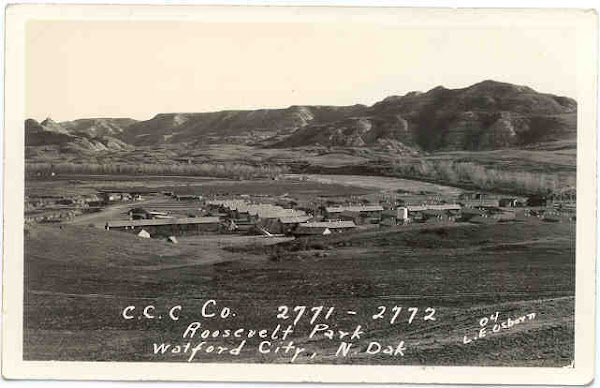
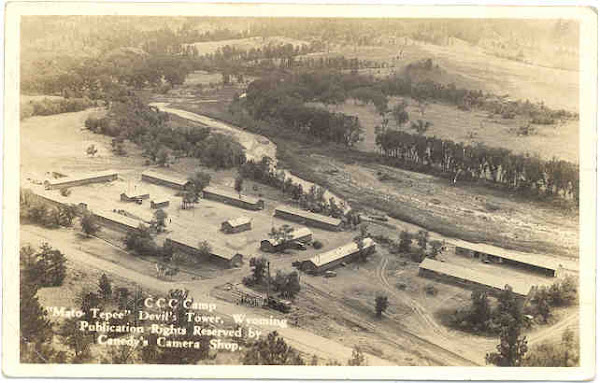
No comments:
Post a Comment